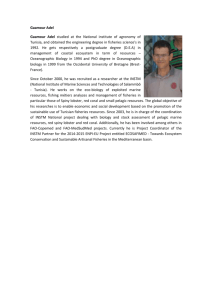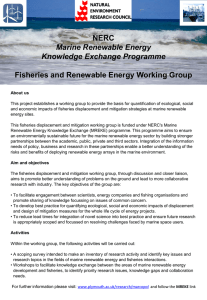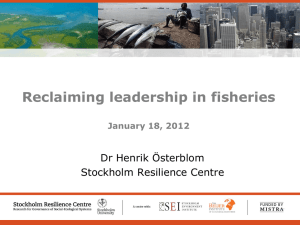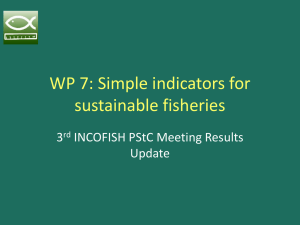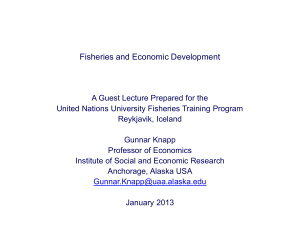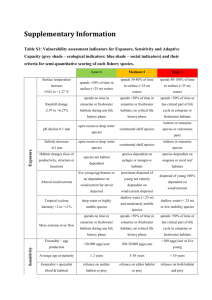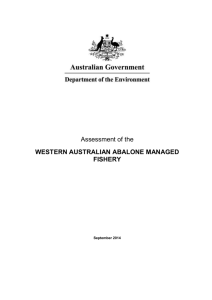Presentation - Environmental Science and Policy Program
advertisement
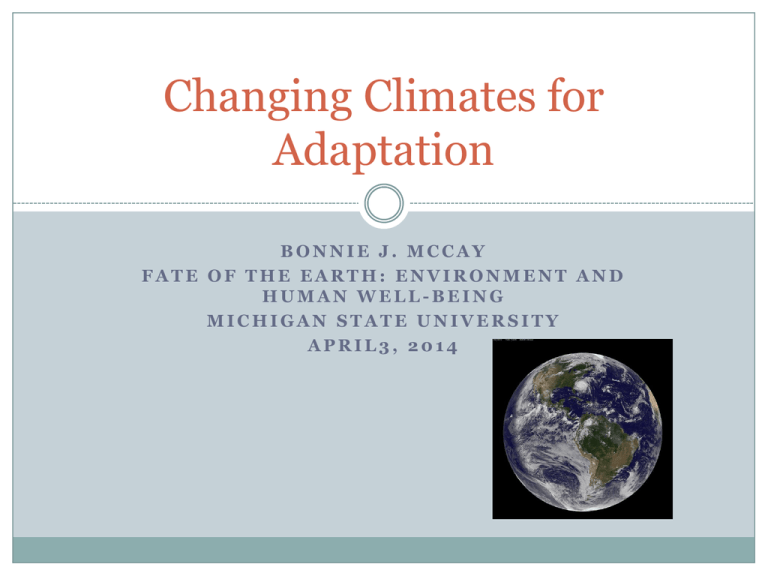
Changing Climates for Adaptation BONNIE J. MCCAY FATE OF THE EARTH: ENVIRONMENT AND HUMAN WELL-BEING MICHIGAN STATE UNIVERSITY APRIL3, 2014 General Lessons Wicked problems… Rittel & Webber 1973 Muddling through strategically Governance of complex systems should be “polycentric” (Ostrom) and “interactive” (Kooiman) Beyond panaceas E. Ostrom 2007 Act boldly, risk failure AO Hirschman (The Hidden Hand) But be adaptive Holling; Gunderson et al. Chas. Lindblom [Participate] Early and Often A. Capone? Once they have seen gay Paree Cultural inertia and resistance You can’t go home again; Path dependency; irreversibility. ITQs Horse is out of the barn [Too little, too late]. Acidification trends in marine fisheries management Market-based Ecosystem-based Commodity-focused Multiple-species Exclusive and Regime shifts tradeable withdrawal or use rights Efficiencies Concentration Incentives for userfunded research Protected areas Hard choices Multi-stakeholder Scale issues Spatial planning Shifting paradigms Climate change: Fates & consequences for the earth’s oceans Warmer sea temperatures Changes in stratification, upwelling, etc. Glacier Melting and Reduction of sea ice Acidification Exploitation pressure Harvesting Dredging Dumping Introducing alien species Changes in living communities: plankton, benthos, pelagics Changes in ecologically productive and sensitive habitats: coral reefs, grass beds, kelp forests, submarine canyons and mtns; etc. Effects on coastal places— sea level rise, storm surges, salinization… DIMINISHED ECOSYSTEM SERVICES & ELEVATED DANGERS Hurricane Sandy from space, Oct. 2012 And then comes the sea “Comedies of the Commons” People as problem- solvers as well as problem-creators People as social beings, trying to deal with and correct what seems out of kilter. “The drama of humans as social rather than private beings, a drama of social actions having a frankly corrective purpose.” (M.E. Smith, 1984; McCay and Acheson 1987). “The Commons” Framework for thought and action “tragedy of the commons” –open access, profit- seeking, little communication or governance. “romances/comedies of the commons” –governance, communication, boundaries of various kinds, efforts to manage for present benefit and sustainable futures. Objectifications: Leviathan, Hidden Hand, Noble Savage….versus more complex unfoldings, social and ecological processes, unexpected outcomes (Boonstra & Heung 2011) Four stories Newfoundland’s Fisheries: Tragedies of the commons and/or regime shifts New Jersey’s surfclam fishery: Privatization of the commons; efficiency, industry initiatives, and climate change Mexico’s lobster and abalone fisheries: Enclosure of the commons, community-based control and comanagement. Marine reserves and resilience. Oregon’s Pacific oyster hatcheries and acidification: surprise, adaptive responses. “Tragedy of the Northern Cod” Fishery closed June 1992. Plot of a tragedy…. Late 1980s, small-scale Contexts: collapse and fishers petitioned for study, review Government scientists found errors in stock assessments Fishery continued nonetheless Official disaster 1992 privatization of corporate, industrial fisheries Inaccuracies, analytic problems with data “We’re all to blame” Scope and scale of fish stocks versus ‘communities” Responses after the cod collapse. Emergence of a more complicated plot Leave fisheries (especially for shale oil and mining in western Canada); rural depopulation Diversify into crustacean fisheries (crab and shrimp), more capital-intensive; more precautionary, exclusive management. Variable water temperatures; quest for stability, with vested interests and political commitments Eco-Certification: commitments to sustainable fisheries through MSC US Northeast: Responses to Climate Change Fisheries followed the fish….but only 10-30% as much. Economic & regulatory constraints Effects on fish stocks of lagged human responses? Incorporation into fish stock assessment and management? Pinsky & Fogarty 2012; McCay 2013 Source: Nye et al. 2009 Surf Clam Case Decline in southern portion of clam distribution Some industry shift north but… 50% of landings from two ten minute squares, tho’ decline in catch rates Opening of northern clam beds despite PSP risks, 2013 Industry resists scientific & regulatory changes; ITQs & global competition Surfclam case study Local-level & nested commons management: a Mexican case FISHING COOPERATIVES OF THE VIZCAINO PENINSULA, BAJA CALIFORNIA SUR Spiny lobster (Panulirus interruptus) a. Lobster 2,000 $40,000,000 1,500 $30,000,000 1,000 $20,000,000 500 0 $10,000,000 income (US Dollars) $50,000,000 1929 1933 1937 1941 1945 1949 1953 1957 1961 1965 1969 1973 1977 1981 1985 1989 1993 1997 2001 2005 catch (t) (live weight) 2,500 Baja Calif. Linkages… Z o n a P acífico N o rte, Á reas C o n cesio n ad as a cad a C o o p erativa 2 9 .0 0 2 8 .8 0 2 8 .6 0 P escadores N acionales de Abulón 2 8 .4 0 2 8 .2 0 2 8 .0 0 La P urísim a 2 7 .8 0 Buzos y P escadores 2 7 .6 0 Bahía Tortugas 2 7 .4 0 Em ancipación 2 7 .2 0 2 7 .0 0 California de San Ignacio Pr ogr eso 2 6 .8 0 Leyes de Reform a 2 6 .6 0 Punta Abreojos 2 6 .4 0 2 6 .2 0 -1 1 6 .0 0 -1 1 5 .6 0 -1 1 5 .2 0 -1 1 4 .8 0 -1 1 4 .4 0 -1 1 4 .0 0 -1 1 3 .6 0 -1 1 3 .2 0 Successful Local-Level “Commons” Management: Being benthic: close scale clarity of social and match between scale of the coop fisheries and biology of the major species & the productivity, visibility and legibility of the resources and fisheries involved; Strong commitment to enforcement and democratic decisionmaking territorial boundaries; adjacency and linkages among territorial units; federation tight embeddedness of the cooperatives and fisheries within communities. (isolation, dependency) McCay et al. 2013 (Marine Policy) Coupling and “negative feedback”— Fishery cooperatives of BCS, Mexico Threats of severe loss through closures “Co-management” arrangements with government agencies “Self-management” internal rules for lobster & abalone Nested “governance” systems, supported by larger political, legal, social systems, linked to larger marine conservation community, globalized markets, and consumers (scales) Experimental marine reserves: Isla Natividad Managing for resilience: the Marine Protected Area experiment 2010 the Coop established experimental closed areas for abalone reef management, with help of NGOs & scientists. Improved lobster & abalone. Local monitoring Anoxic event 2012, die-off of abalone. Commitment to marine reserve strategy Responses to Acidification: the West Coast Oyster Case Whiskey Creek Hatchery, Oregon Responses 2007-08 die-off Research, CO2; carbonate less experimentation Change in practices in hatcheries available, esp. upwelling water Industry lobby; funds for research; Monitoring systems; increase carbonate levels; Lummi use saltwater pond What to do? Tall orders national, international, and regional authorities Global, regional, ‘large marine ecosystem’ scales ENGO and governmentled programs: coral triangle; MPA networks; Marine spatial planning; high seas fisheries; dealing with IUU; Ecocertification;…. Short orders Local and communityoriented Small scale enterprises Traditional & experiencebased knowledge partnerships for “commons” science & management Place-based TURFs and MPAs Community-supported fisheries Linkages Vertical : “Co- management” & nested governance Local group/ outsiders (NGOs, scientists)/ government authority Shared decision-making, authority, responsibility Large- and small-scale fisheries Horizontal: networks Ex.: Too Big to Ignore network (Canada); 2nd World Small-Scale Fisheries Congress 21-25 Sept. 2014, Merida, MX World Ocean Council Eco-certification programs Marine Stewardship Council Four stories Newfoundland’s Fisheries: Tragedies of the commons and/or regime shifts; New Jersey’s surfclam fishery: Privatization of the commons; efficiency, industry initiatives, and sea temperature change Mexico’s lobster and abalone fisheries: Enclosure of the commons, community-based control and comanagement. Marine reserves and resilience in face of ocean changes. Oregon’s Pacific oyster hatcheries and acidification: surprise, adaptive responses. >>all beg the question of ecosystem-based management Ecosystem-Based Management & Adaptive Governance Challenge---large spatial scope, more complex subject: Centralized decision-making for multi-disciplinary expertise, knowledge accumulation and analysis, interagency coordination But also more Decentralized and Participatory across multiple scales, to monitor and capture detailed knowledge about ecological & social processes across local to global scales Wilson 2009 General Lessons It’s wicked… Rittel & Webber 1973 Governance of complex systems should be “polycentric” (Ostrom) and “interactive” (Kooiman) You can’t go home again; Path dependency; irreversibility. ITQs Horse is out of the barn [Too little, too late]. Acidification Beyond panaceas E. Ostrom 2007 Act boldly, risk failure AO Hirschman (The Hidden Hand) But be adaptive Holling; Gunderson et al. Muddling through vs. Strategic Planning Chas. Lindblom [Participate] Early and Often A. Capone? Once they have seen gay Paree Cultural inertia and resistance Thank you Questions?
